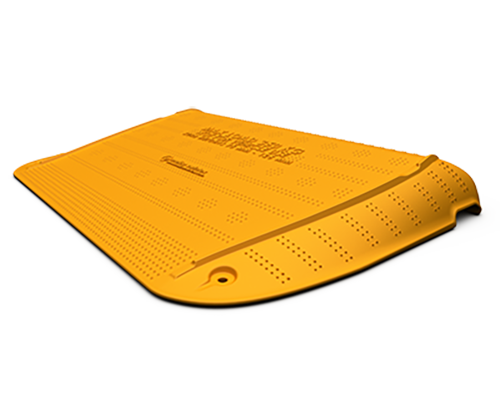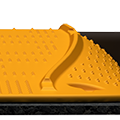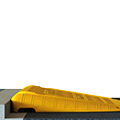Designed in conjunction with the University of East Anglia, led by Dr Katherine Deane BSc PhD - Senior Lecturer in Research, and her team.
A uniquely designed ramp focused for people of varying abilities to overcome the issues that all current wheelchair ramps have. Extremely stable when in use, with excellent grip on its surface in all conditions. A consistent ramp angle allows multiple angle entry/exit.Features
Transport
Standards
– A Code of Practice.
Spec Sheet:

The developers at Melba Swintex actually listened and worked with myself, other wheelchair users and visually impaired people to produce a ramp that is safer and easier to negotiate.Dr Katherine Deane BSc PhD
Senior Lecturer in Research at the University of East Anglia.
Organic Form
The design of current Wheelchair Ramps forces the user to approach the ramp straight on due to the high-rise walls either side of the ramp. This causes major issues when there is insufficient clearance for a wheelchair user to approach the ramp. As well as this, the high-rise walls for the visually impaired can cause serious trips and falls that could have been prevented.
The RightRamp has been designed to sit up against the kerb, rather than over it, which allows the form of the ramp to blend from the road surface up into the kerb. The organic curvature of the ramp allows multiple angle access when approaching the ramp from both the road works, and the pavement.
In Collaboration With
Kerb Heights
Extensive research into the most common kerb heights around pedestrian areas has concluded that there is a vast variation in kerb heights seen globally, with 75 mm – 125 mm being the most common varying heights. With this information, a series of trials were conducted to determine the precise form that allows the smoothest transition onto and off the ramp for the varying kerb heights.
Working with a minimum castor wheel size of 4 inches, the RightRamp implements a specially designed back face that allows a wheelchair user to transition seamlessly onto and off the ramp at various heights. For more information on placement of the ramp, see our Fixing Instructions.













